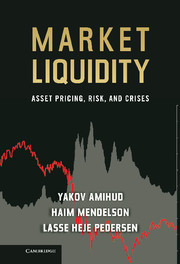Book contents
- Frontmatter
- Contents
- Acknowledgments
- Introduction and Overview of the Book
- Part I The Effect of Liquidity Costs on Securities Prices and Returns
- Chapter 1 Asset Pricing and the Bid–Ask Spread
- Chapter 2 Liquidity, Maturity, and the Yields on U.S. Treasury Securities
- Liquidity, Maturity, and the Yields on U.S. Treasury Securities*
- Chapter 3 Market Microstructure and Securities Values: Evidence from the Tel Aviv Stock Exchange
- Market Microstructure and Securities Values Evidence from the Tel Aviv Stock Exchange*
- Part II Liquidity Risk
- Part III Liquidity Crises
- References for Introductions and Summaries
- Index
Chapter 3 - Market Microstructure and Securities Values: Evidence from the Tel Aviv Stock Exchange
Summary and Implications
Published online by Cambridge University Press: 05 December 2012
- Frontmatter
- Contents
- Acknowledgments
- Introduction and Overview of the Book
- Part I The Effect of Liquidity Costs on Securities Prices and Returns
- Chapter 1 Asset Pricing and the Bid–Ask Spread
- Chapter 2 Liquidity, Maturity, and the Yields on U.S. Treasury Securities
- Liquidity, Maturity, and the Yields on U.S. Treasury Securities*
- Chapter 3 Market Microstructure and Securities Values: Evidence from the Tel Aviv Stock Exchange
- Market Microstructure and Securities Values Evidence from the Tel Aviv Stock Exchange*
- Part II Liquidity Risk
- Part III Liquidity Crises
- References for Introductions and Summaries
- Index
Summary
Examining liquidity differences between financial assets, the preceding articles show that trading costs or illiquidity affect the prices of financial assets. By the same logic, an increase in the trading costs of a given financial asset should lower its price, and a decline in trading costs should lead to a price increase. For example, if a stock is transferred to a trading venue with better liquidity, which means lower trading costs, its price is expected to rise. However, changes in trading venue, which are usually voluntary, are often associated with changes in information about the asset, asset risk, or other asset attributes.
This difficulty is overcome in the study of Amihud, Mendelson, and Lauterbach by examining the effect of an exogenous change in stocks’ trading venue. This was the case when the Tel Aviv Stock Exchange (TASE) transferred stocks from a once-a-day call auction trading to a higher-frequency (and more liquid) trading regime. The transfer decisions were made by the management of the TASE without any company discretion and were pure change-of-liquidity events without any information about the stocks’ future cash flows. This comes as close as possible to a true controlled experiment on the effects of changing the liquidity of trading on asset values. Here, the liquidity-increasing event is exogenous and clearly identified, and the change in the stock value that immediately follows can be directly attributed to this event.
- Type
- Chapter
- Information
- Market LiquidityAsset Pricing, Risk, and Crises, pp. 69 - 71Publisher: Cambridge University PressPrint publication year: 2012



